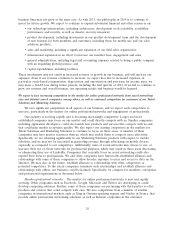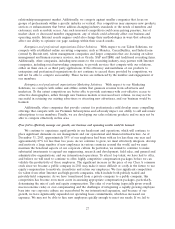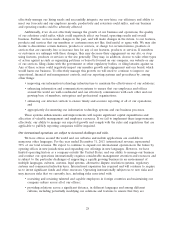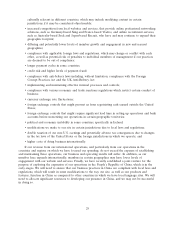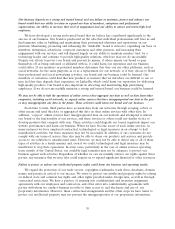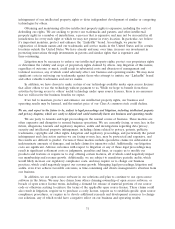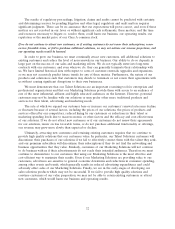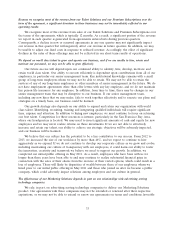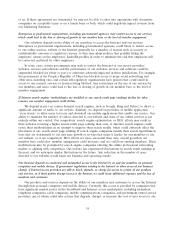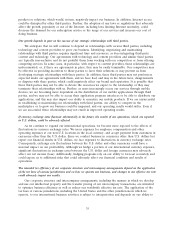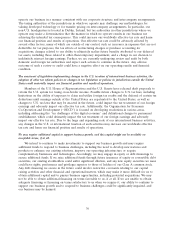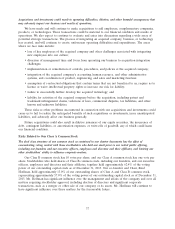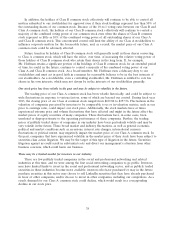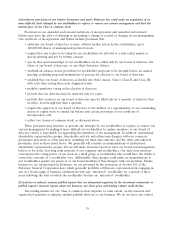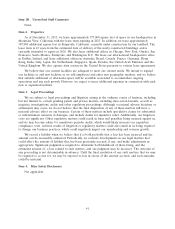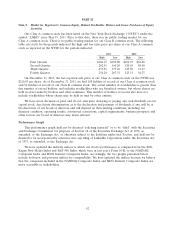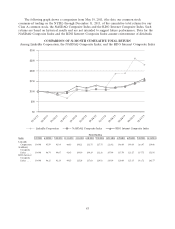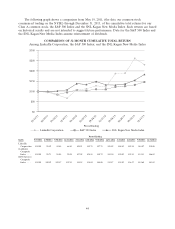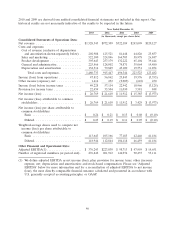LinkedIn 2013 Annual Report Download - page 38
Download and view the complete annual report
Please find page 38 of the 2013 LinkedIn annual report below. You can navigate through the pages in the report by either clicking on the pages listed below, or by using the keyword search tool below to find specific information within the annual report.operate our business in a manner consistent with our corporate structure and intercompany arrangements.
The taxing authorities of the jurisdictions in which we operate may challenge our methodologies for
valuing developed technology or for transfer pricing on intercompany arrangements. In particular, our
non-U.S. headquarters is located in Dublin, Ireland, but tax authorities in other jurisdictions where we
operate may make a determination that the manner in which we operate results in our business not
achieving the intended tax consequences. This could increase our worldwide effective tax rate and harm
our financial position and results of operations. Our effective tax rate could be adversely affected by
several other factors, many of which are outside of our control, such as: increases in expenses that are not
deductible for tax purposes, the tax effects of restructuring charges or purchase accounting for
acquisitions, changes related to our ability to ultimately realize future benefits attributed to our deferred
tax assets, including those related to other-than-temporary impairment, and a change in our decision to
indefinitely reinvest foreign earnings. Further, we are currently undergoing review and audit by both
domestic and foreign tax authorities and expect such actions to continue in the future. Any adverse
outcome of such a review or audit could have a negative effect on our operating results and financial
condition.
The enactment of legislation implementing changes in the U.S. taxation of international business activities, the
adoption of other tax reform policies or changes in tax legislation or policies in jurisdictions outside the United
States could materially impact our financial position and results of operations.
Members of the U.S. House of Representatives and the U.S. Senate have released draft proposals to
reform the U.S. system for taxing cross-border income. Possible future changes to U.S. tax laws, including
limitations on the ability of taxpayers to claim and utilize foreign tax credits and the deferral of certain tax
deductions until earnings outside of the United States are repatriated to the United States, as well as
changes to U.S. tax laws that may be enacted in the future, could impact the tax treatment of our foreign
earnings and adversely impact our effective tax rate. Additionally, the Organisation for Economic
Co-Operation and Development (‘‘OECD’’) is focused on developing resolutions in various areas,
including addressing the ‘‘tax challenges of the digital economy’’ and definitional changes to permanent
establishment, which could ultimately impact the tax treatment of our foreign earnings and adversely
impact our effective tax rate. Due to the large and expanding scale of our international business activities,
any changes in the U.S. or international taxation of such activities may increase our worldwide effective
tax rate and harm our financial position and results of operations.
We may require additional capital to support business growth, and this capital might not be available on
acceptable terms, if at all.
We intend to continue to make investments to support our business growth and may require
additional funds to respond to business challenges, including the need to develop new features and
products or enhance our existing solutions, improve our operating infrastructure or acquire
complementary businesses and technologies. Accordingly, we may engage in equity or debt financings to
secure additional funds. If we raise additional funds through future issuances of equity or convertible debt
securities, our existing stockholders could suffer significant dilution, and any new equity securities we issue
could have rights, preferences and privileges superior to those of holders of our Class A common stock.
Any debt financing we secure in the future could involve restrictive covenants relating to our capital
raising activities and other financial and operational matters, which may make it more difficult for us to
obtain additional capital and to pursue business opportunities, including potential acquisitions. We may
not be able to obtain additional financing on terms favorable to us, if at all. If we are unable to obtain
adequate financing or financing on terms satisfactory to us when we require it, our ability to continue to
support our business growth and to respond to business challenges could be significantly impaired, and
our business may be harmed.
36


